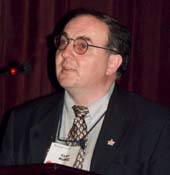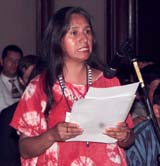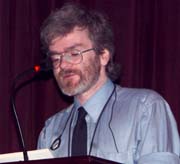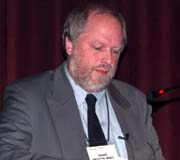 |
San José, Costa Rica 10-18 May 1999 |
|
Briefing |
|
Delegates at COP7
participated in Technical Sessions on National Planning for Wetland Conservation
and Wise Use in the morning and on Involving People at All Levels in the
Conservation and Wise Use of Wetlands in the afternoon. A Memorandum of
Understanding was signed between Ramsar and the World Heritage Convention. |
|
|
| Sara Diof (Senegal), SC Representative for Africa, presented the draft resolution on the Strategic Framework and guidelines for the future development of the List of Wetlands of International Importance. He said the proposed strategic approach for designating these wetlands aims to establish an international network of wetlands, with a target of 2000 sites by COP9. | |
|
David
Stroud, Joint Nature Conservation Committee (UK), reported on the deliberations
of a focus group on the Strategic Framework and guidelines for identifying
and designating karst and other subterranean hydrological systems. The
group stressed the importance of the resolution on enhancing conservation
and wise use of intertidal wetlands and recommended strengthened links
between these resolutions. They concluded that the guidelines for designation
of karst systems should eventually be merged with the Strategic Framework.
|
|
| Clare Shine, IUCN Environmental Law Center, presented the guidelines for reviewing laws and institutions to promote the conservation and wise use of wetlands. She recalled that CPs are urged to conduct legal and institutional reviews to identify measures that undermine conservation and wise use and support the development of positive legal and institutional frameworks for wise use. | |
|
Clayton
Rubec, Canadian Wildlife Service, made a presentation on the Guidelines
for developing and implementing National Wetland Policies (NWPs). He highlighted
progress in the development and implementation of NWPs in Contracting
Parties (CPs). He noted that few CPs have stand-alone wetland policies,
although many are in preparation.
|
 |
| Hans Skotte Moller, Danish National Forest and Nature Agency, discussed restoration as an element in national planning for wetland conservation and wise use. He noted that rehabilitation initiatives of modified and degraded wetlands were taking place in numerous Ramsar CPs. He said these efforts were scattered and rarely integrated into national legislation and planning schemes. He observed that wetlands may be the first major ecosystem rehabilitated by humankind on a global scale. | |

|

|
|
|
|
|
Victor Pulido, National Wetland Programme (Peru), made a presentation on participatory processes to involve local communities and indigenous people in wetland management.
|
 |

|

|
|
(Text of the statement in Spanish) Final document
from the Indigenous Peoples’ Regional Workshop: |
|
Back to ENB's Ramsar COP7 home page
© Earth Negotiations Bulletin, 1999. All rights reserved.



